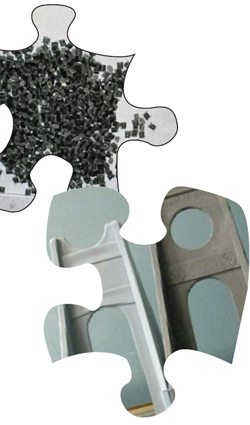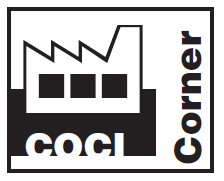|
|
Vol.
35 No. 1
January-February 2013
At the IUPAC Committee on Chemistry and Industry workshop* in Toronto in June 2012, Mohini Sain, a professor from the Centre for Biocomposites and Biomaterials Processing (CBBP) of University of Toronto, Canada, shared his experiences translating university research into business opportunities while maximizing the use of local sustainable resources.
by Ruijun Gu and
Mohini Sain
 |
| Examples of GreenCore products. Copyright 2012. By permission of GreenCore and Ontario BioAuto Council. |
Millions of tons of sustainable materials are generated annually from forest biomass (i.e., barks, nuts, etc.), agricultural and food waste (i.e., wheat stalk, corn stover, crab shells, etc.), processing byproducts (i.e., lignin from pulping process), bio-energy byproducts (e.g., from ethanol production) and sludge from the paper industry and municipal treatment plants. Many researchers have conceptualized how to implement disruptive technologies using these materials. However, making the transition to commercialization can be quite difficult.
Industry-sponsorship programs have proven successful in facilitating commercialization of university research. And industry- or privately-funded centers are emerging as another model for fostering technological innovation at research universities. There is a third path based on our experience at CBBP: pre-commercializing green innovations to create disruptive technologies.
This approach has proven very successful, and has led to joint ventures, direct technology transfer, and start-ups. Since 2005, three start-up companies have spun off from projects of CBBP. The companies produce green polymers and additives out of agricultural residue. Over the past decade, CBBP innovations have led to natural-fiber-reinforced lightweight automotive parts, bio-based polyurethane cushions, protein-derived coatings, and biodegradable thermoplastic starch. The approach follows a stage-gate solution through scientific and engineering challenges, economic performance, and pre-commercialization. The important point is how to minimize early stage “cash burn” and implement an effective investment fund.
GreenCore Composites Inc., a spin-off from CBBP’s Auto21 project, produces plastic composites that offer clear advantages and high integrities through wood and agricultural fiber reinforcement. After a lengthy economic-performance evaluation, proprietary high-quality pellets of polymer composites were launched in the automotive and construction markets. Eventually, it required large non-public investments to start its production and expand from 1.5 million pounds to 5 million pounds
annually.
Currently, CBBP is supporting GreenCore by introducing proprietary microfibre into composites. In addition, CBBP continues to support industrial innovation through direct transfer of technology to industry, such as natural-fiber reinforcements for Magna International and bast-fiber door panels for BASF for use in the BMW 7 Series sedan.
Biological materials have gained prominence as thermoplastic starch, nanofibers, and sustainable proteins. Nanofiber is a material composed of nanosized cellulosic fibrils with typical lateral dimensions in the range of 5–20 nanometres and longitudinal dimensions in a wide range from 10 nanometres to several microns. Nanofiber exhibits a thixotropic property and is a renewable, recyclable, and abundant nanomaterial made of cellulose fibers from the wood pulp manufacturing process, agricultural feedstock, or special bacteria. There are three main types of nanofibers, which there are distinguished by the manufacturing processes used to create them: mechanical disintegration procedure,1,2 chemical isolation process,3 or bacterial generation.4
 |
PolyBio Inc., a spin-off from one of CBBP’s industrial collaborative projects, develops novel fungal plastics, polysaccharides, and proteins as well as nanofiber technology derived from agricultural residues. CBBP has granted a license for nanofiber manufacturing to PolyBio Inc., allowing it to use patented nanofiber technology from agricultural feedstock and to develop value-added applications. In contrast to other techniques, this proprietary technology makes it feasible to produce nanofiber from agricultural feedstock (such as wheat stalk) through mechanical defibrillation with enzymatic treatment. The process requires less energy and chemical consumption compared to conventional mechanical homogenization and electronic spinning. With funding from an ISTP Brazil-Canadian industry partnership, a pilot-scale device has been built at the center. According to CBBP, the nanofiber can be used to make iridescent flexible bio-nanocomposite films, biodegradable barrier packaging films, nano-coating for automotive products, and a host of other products to increase the biodegradability of polymer films.
PolyBio Inc. also markets fungal modified starch, which has already been pre-commercialized in the form of the starch/PVC blend under the names of PolyCarb® and PolyPearl® with the technical support of CBBP. The technology of PolyCarb® has been transferred to Canadian General-Tower Ltd. so it may produce biodegradable Vehreo® lightweight automotive cover stocks in its Cambridge facility.
No company wants to take the risk of producing a product no one wants. For example, a student research work is to justify a problem and identify the problem, and then propose solution to that problem. The solution might nurture customers related for rapid commercialization before a cost-performance evaluation completed. Under such circumstance, Engineered Biofibre Inc. is a prime example of a joint venture company led and promoted by students. The company, which turns industrial sludge, digestate, and lignosulfonate into biodegradable packaging and others materials, has entered into agreements with pulp mills, plastic processors, and automotive manufacturers that are beneficial to both sides.
 |
| PolyBio biocomposites made from waste residues and plastics. |
So, what are the results of Canadian incentives for university-industry collaboration? How can we facilitate the commercialization of university research? Obviously, university commercialization is important because it creates tangible outputs from public investments and provides a return. However, some of the major hurdles for university research commercialization are lack of interest and new business procurement legislation, lengthy market validation resulting in high risk, and poor management and value-chain networks. One of the biggest challenges is how to identify a good platform for new product launching.
Ruijun Gu <[email protected]> is a research scientist at the University of Toronto, a member of PAPTAC, Auto21, and the Ontario BioCar Initiative. Mohini Sain <[email protected]> is the dean and professor of Faculty of Forestry of the University of Toronto. He is also the director of the Center for Biocomposites and Biomaterial Processing. Sain is the chief scientist of Ontario BioAuto Council and the principal investigator of Ontario BioCar Innovative.
References
- Ayse Alemdar and Mohini Sain. Biocomposites from wheat straw nanofibres: Morphology, thermal and mechanical properties. Composites Science and Technology. 2008, 68(2): 557-565.
- Sreekumar Janardhnan and Mohini Sain. Targeted disruption of hydroxyl chemistry and crystallinity in natural fibres for the isolation of cellulose nano-fibres via enzymatic treatment. BioResources. 2011, 6(2): 1242-1250.
- Paul B. Filson and Benjamin E. Dawson-Andoh. Sono-chemical preparation of cellulose nanocrystals from lignocellulose derived materials. Bioresource Technology. 2009, 100(7): 2259-2264.
- M. Schramm and S. Hestrin. Factors affecting production of cellulose at the air/liquid interface of culture of Acetobacter xylinum. Journal of General Microbiology. 1954, 11(1): 123-129.
 |
*The COCI workshop held in Toronto 1-2 June 2012 was the fourth in the series; previous events were held in Marl, Germany on 24-25 April 2008, and Kawasaki, Japan 7-8 April 2009, and on a smaller scale in Kuwait on 9 March 2010. The goals of the workshops are to improve communications among chemical industries, chemical societies/NAOs, and IUPAC through its Committee on Chemistry and Industry. The 2012 workshop focusing on the Great Lakes Area in North America was coordinated by Bernard West. For more details see IUPAC project 2011-053-1-022 (www.iupac.org/project/2011-053-1-022).
Page
last modified 8 January 2013.
Copyright © 2003-2013 International Union of Pure and Applied Chemistry.
Questions regarding the website, please contact [email protected] |